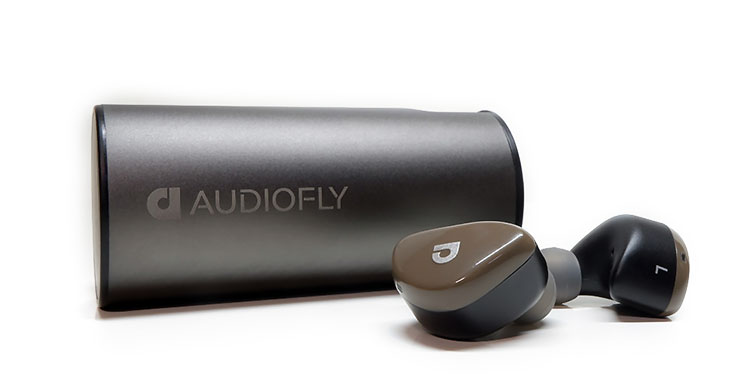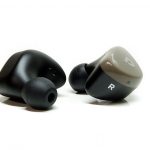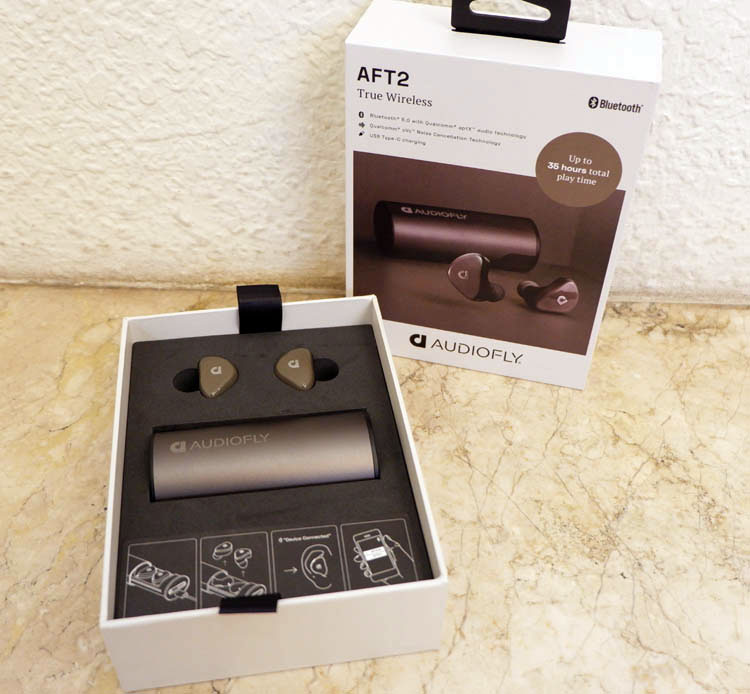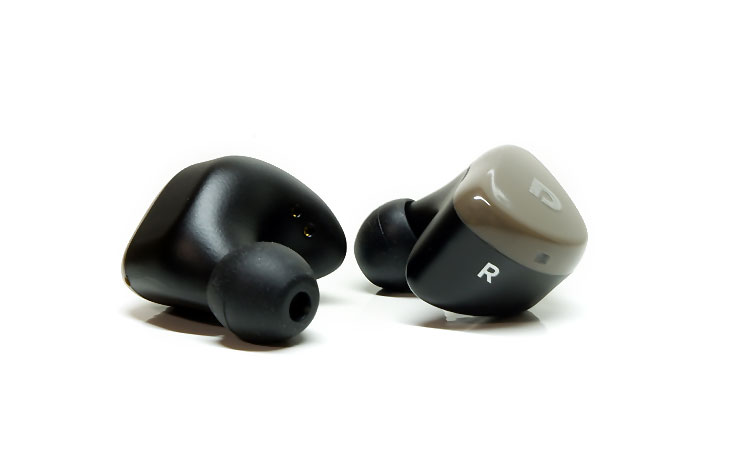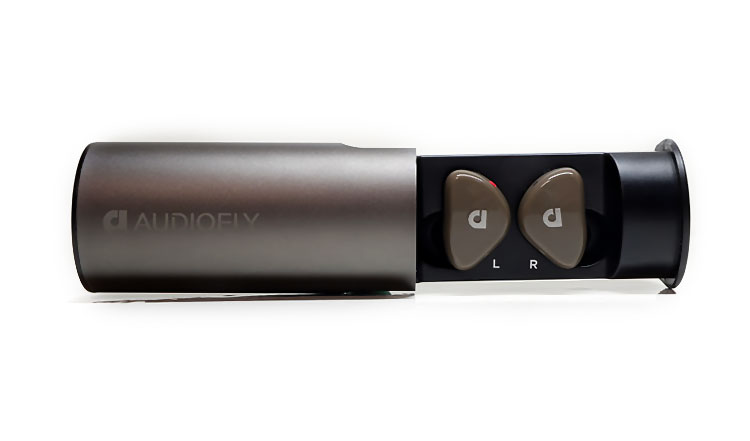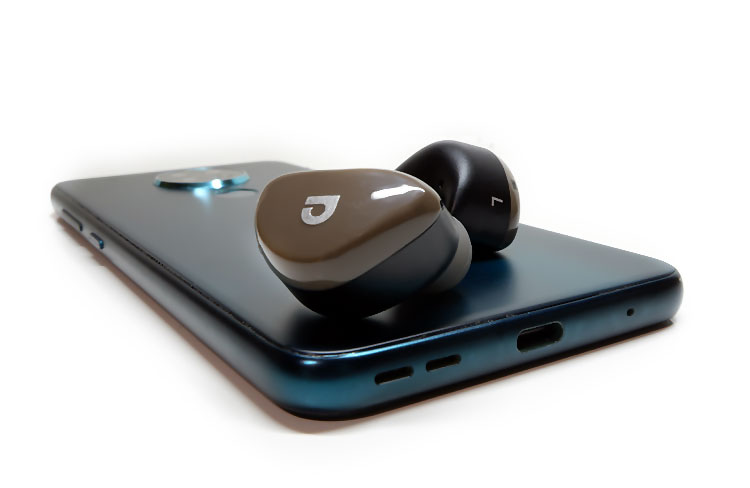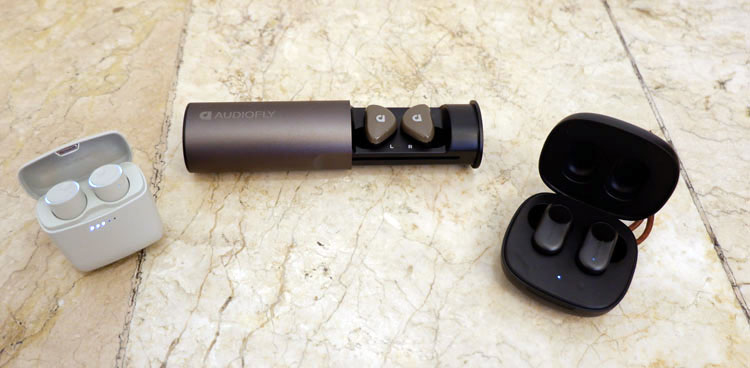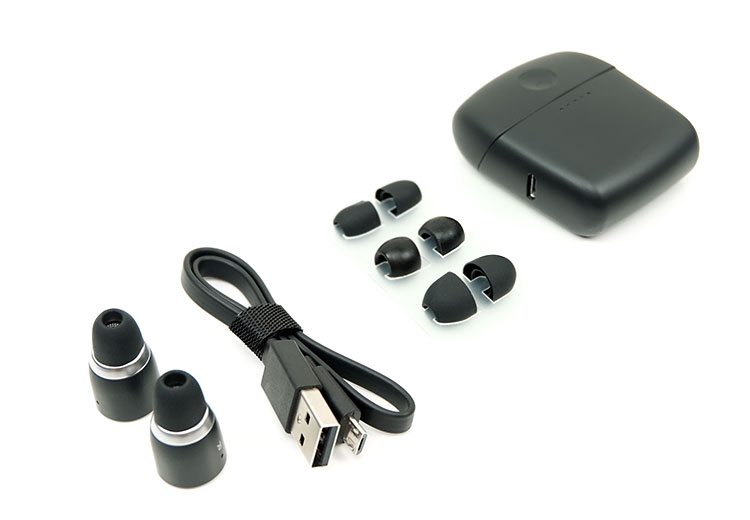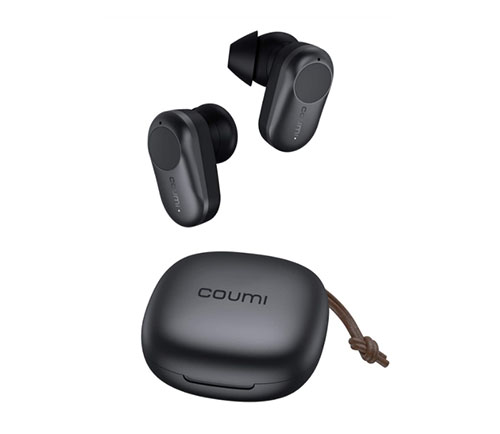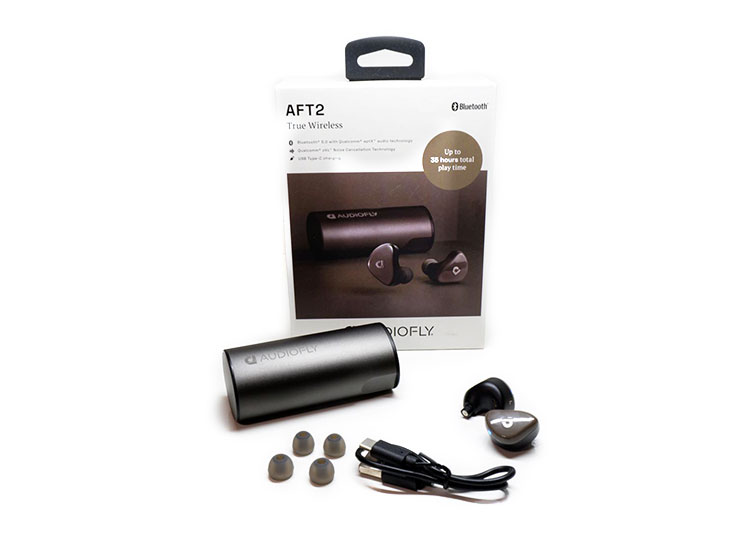The Audiofly AFT2 is a 6mm single dynamic driver TWS with Bluetooth 5.0, aptX, and up to 35 hours of total battery life. It is priced at $129.99
Disclaimer: The Audiofly AFT2 sent to us is a sample in exchange for our honest opinion in this review. We thank the team from Audiofly for giving us this opportunity.
To read more about TWS products we have reviewed on Headfonics, click here.
Note, this review follows our new scoring guidelines for 2020 which you can read up on here.
Audiofly hail from Australia and have been manufacturing professional studio and audiophile IEMs since 2012. They have plenty of experience in designing and manufacturing IEMs with dynamic and balanced armature drivers.
The AFT2 is part of their debut TWS series, the other being the slightly lower-end AFT1. The pricing is a little above the budget level at $129.99 but it does come with plenty of features and a cool design to back up the price pitch.
Packaging & Accessories
The AFT2 arrived in their retail packaging, and the printing on the box is high resolution, but most importantly, it shows the pertinent specifications of the AFT2. Opening the package, and the earbuds are separated from the case itself so that the earbuds wouldn’t constantly be charging while they are in transit or on store shelves.
Removing the foam insets would reveal the short USB cable and a pair of ear tips that come with the AFT2. Then finally there’s an instruction manual, that I found to be informative and well written.
Tech Inside
The Audiofly AFT2 comes with 6mm dynamic drivers inside, driven by a pair of neodymium magnets for higher magnetic flux density. This would give the AFT2 a good amount of control over the driver, and ideally a better dynamic range as a result.
The AFT2 was also designed with comfort in mind so they have taken some of the ergonomic principles that they have gained from their experience with creating custom IEMs, and have implemented some of it in the AFT2.
Audiofly has also equipped the AFT2 with Bluetooth 5.0 dual-mode using a Qualcomm chipset, Qualcomm cVc 8.0 noise-canceling technology, and a host of supported Bluetooth Codecs that include SBC, ACC, up to aptX. The AFT2 comes in 4 colors, Granite, Sunset, Sand, and Gum Leaf. The one that was sent to us is the Granite version.
IPX5 certification
IPX certification is a certification where the 1st number indicates the dust resistance, and the 2nd indicates the water resistance level. The higher number would indicate a higher amount of resistance against the elements.
The AFT2 has an IPX5 certification, which means that the device is tested for protection against a water jet from a 6.3mm nozzle at 12.5Liters/minute, at a 30kPa pressure from 3 meters for up to 3 minutes.
This means that the AFT2 is protected against sweat, but not much more, as this certification would not protect the AFT2 from taking it with you in a shower. But sweating it out in a gym or a long jog would be feasible with the AFT2.
Call quality
With the introduction of Qualcomm cVc noise-canceling technology, the AFT2 can block out some of the ambient noise during a call. My voice calls actually seem to be quite clear on the other end of the line when tested during this review.
I even tested the earbuds with a fan blowing directly at the earbuds, and the other end of the line only heard the sound of my voice. I found that the quality of the call improved over some older TWS earbuds also.
Design
The earbuds themselves hark back to Audiofly’s IEM design roots, as many of the elements that were used to create the design of the AFT2 incorporated. The AFT2’s earbuds seem to be a bit larger than the typical TWS earbuds, but the size and design do have some benefits.
The shape of the earbuds are ergonomically shaped to follow the contours of the inside of the ears, so their large size doesn’t seem like too much of a downside anymore.
On the top part of each earbud, is an LED that indicates the status of the connection and charge. Red indicates that it’s charging, alternating between red and blue to indicate pairing, and finally a slightly longer blue flash to indicate that the AFT2 has successfully paired with my phone.
Comfort & Isolation
With the bigger shell though, one would have the impression that the AFT2 might be a bit heavy or uncomfortable. However, once they are in my ears, I would only start to notice their presence after more than an hour of use, which is how I feel when I wear any IEM or TWS for 1 to 2 hours.
Since the design of the AFT2 is similar to traditional IEMs, ear tips from traditional IEMs can be used with the AFT2. The sound of the AFT2 was further enhanced with the Final Type E ear tips, but I needed to shave 1mm or so from the stems, to make sure that the earbuds our properly fit into the case, and they would still charge.
Some other tips might fit though, so tip rolling is a definite possibility with the AFT2.
Cradle
This is a fairly large but attractive cradle. It’s cylindrical, and the end of the case needs to be pulled out to reveal the earbuds themselves. The slide mechanism on the AFT2 is smooth and has a satisfying click when it’s opened or closed. The mechanism also seems quite robust, so I’m not too afraid of wearing it out prematurely.
The finish on the case is also quite nice. The outer metal shell seems to be anodized, and laser engraved, which ensures the longevity of the finish. The plastic parts of the case also seem to be made of hard plastic.
Aside from the slide mechanism, the case also has a 4-level battery indicator and a single button to activate the 4 battery level LEDs. This alleviates my anxiety over not having enough battery on my earbuds for the rest of the day. Charging the case is thankfully done through a USB-C port and not micro-USB.
The slots for the earbuds inside the case are easy to work with. The magnets for the earbuds keep the earbuds securely in place. When inserted they are immediately deactivated to prevent battery drain.
Controls
The AFT2 uses a touch control system so there are pros and cons with that given its smooth flat faceplate.
They are the typical touch controls such as a single tap for pause/play and double-tap on the left is for the previous track. Double-tap on the right is for the next track. If you touch and hold on the left earbud this will decrease the volume, and on the right earbud, it increases the volume.
There is no app however to tweak these controls, they are set in place. However, the implementation of the controls is good. They have a fast response, which means I won’t end up overshooting my desired volumes and they do not seem too prone to accidental activation when handling.
Aside from the snappy response, the AFT2 also has a few other control checks. When one earbud is returned to the charging case, the next track, previous track, and volume controls are immediately disabled.
This keeps me from grabbing the other earbud or my phone to counteract the inadvertent volume or track change command from that earbud that I’m still using.
Battery
Real-world testing of the earbuds of the AFT2 seems to last around 7 hours at around 85% volume running on aptX on a single charge which is above average for a pair of TWS earbuds. On the box, it says 10 hours per charge from each earbud, but maybe I could get it closer if I lower my listening volume and run on A2DP only.
The cradle battery performance in the case though is a different story. The AFT2 comes with one of the biggest carrying cases on any TWS that I’ve seen. However, that bigger case will give quite a bit of juice, as it can recharge the earbuds up to 3 times with an additional 25 hours top-up.
My personal experience with the battery life of the total package is around 28 to 30 hours of real-world use. It might be a bit lower than what the box says it is, but that amount should be enough for most situations.
Wireless Performance
Pairing
Connecting the AFT2 to my phone was simple enough. It was just a matter of pairing one of the earbuds to my phone, then the other earbud will automatically connect to my phone. It’s your typical Qualcomm True Wireless set up, and it’s implemented well.
Latency
When I tried watching videos or playing games with the AFT2, I barely noticed any discrepancy between the audio being played, and the video on the screen. I investigated if there is any measurable latency between audio and video, and I found that there is a maximum of 2mS of audio lag, something that I can barely detect in real-world situations.
Range & Stability
Walking around the house with the earbuds, I found the connection of the AFT2 to be stable enough when I’m staying in the same room. When I left my small home office, the connection started to drop off a little bit even when I was still staying well within a 10m radius of my phone.
However, I was not too surprised, since the walls in my house are a bit thick. I’m sure this wouldn’t be the most common use case though, as your phone would be in your pocket most times when using TWS earbuds.
The connection from my phone to the AFT2 is stable, and most importantly, connecting from my phone to the AFT2 is seamless.
Sound Impressions
Bass
The bass on the AFT2 packs a bit of a punch, especially in the mid-bass region but it has a slight drop off towards the sub-bass region. The overall bass on the AFT2 though is sufficient and presented well.
Now, anyone can create some thumping bass, but what I liked with the AFT2 is how controlled the bass actually was. Though there is a respectable amount of bass, it never ends up being boomy or scattered. The low-end is well controlled, meaning the internal amplifier can properly control the drivers inside the AFT2.
Midrange
The overall impression that I got from the AFT2’s midrange is that the lower midrange seems to be slightly elevated, thick, warm, and well-articulated.
In contrast, the upper midrange seems to be slightly recessed in favor of a bass/treble bias. Strings also seem to shine with the AFT2, as guitar plucks tend to sound natural.
Treble
The lower treble is slightly more elevated compared to the upper midrange on the AFT2, and it slowly rolls off as it goes towards the upper treble region.
Although I’m not the biggest fan of treble, I find that the AFT2 can present a good amount of treble information while never-ending up splashy or sibilant. I would have wanted to hear a bit more air from the AFT2 though, but the overall treble presentation is quite pleasant.
Staging
While the soundstage on the AFT2 is not overly spacious with a fairly in your head listening experience. However, what impressed me with the AFT2 is its ability to create a coherent center image and present some sound elements in certain places within the sound stage.
The sound from the AFT2 seems to always remain in my head, but it doesn’t end up feeling congested, because of the AFT2’s ability to create a nice coherent image.
Select Comparisons
Cambridge Audio Melomania
Technical
Physically, the 2 devices couldn’t be more different. The Melomania 1 has a small case, and the earbuds are tiny as in they never touch my ear lobes.
And honestly, the smaller size of the earbuds would contribute slightly to a more comfortable listening session for me. However, the Melomania is showing its age by way of the micro USB port, as opposed to the USB C port on the AFT2.
Also glaringly absent on the Melomania are touch controls. Instead, the Melomania has 1 button on each earbud. But it boils down to preference when it comes to touch control against a physical button. And of course, the Melomania doesn’t have any noise-canceling features, so ambient noise will get through when listening, and more importantly during calls.
The case of the Melomania is just as well made as the AFT2’s carrying case, except that maybe the Melomania has a much more traditional TWS form factor.
The magnetic closure and the metal hinge at the back makes it feel just as satisfying to open and close. Battery life on both devices is comparable, even if the AFT2 seems to have quite a bit more space for a potentially bigger battery.
Performance
The sound signature on both is eerily similar. I think the biggest difference is that the Melomania has a slightly more extension at the frequency extremes compared to the AFT2. Overall details and texture are pretty much equal on both earbuds though.
Soundstage and imaging are pretty much even on both, but I believe that the AFT2 seems to be able to present a slightly more tangible image compared to the Melomania.
With a slightly more modern design and updated features such as noise-canceling, the AFT2 is showing what a modern TWS earbud should be feature-wise. However, the overall sound of the 2 TWS earbuds is quite similar, only having slight differences in tonality.
Coumi ANC-860
Technical
The Coumi ANC-860 is another recently released TWS earbud that has ANC capability, similar to what can be found with the AFT2. However, the price of the Coumi ANC-860 is less than half that of the AFT2, so there would be quite a few compromises.
First is that the ANC-860 has just 1 LED light that indicates the amount of battery left in the case, I missed the 4 level battery indicator when I went from the AFT2 to the ANC-860. The case that came with the ANC-860 is also a bit smaller and has a more casual design when compared to the more industrial aesthetic on the AFT2.
Also, the earbuds on the ANC-860 have quite a different form factor. While I loved how the AFT2’s nozzles are the same as the ones on traditional IEMs, the ANC-860 went the opposite direction.
The ANC-860 only accepts their own ear tips, as the shells have a similar shape to the original Apple Airpods, then a silicon cover with ear tips are put on top of the earbuds themselves. This is a proprietary design, so tip rolling would be close to impossible on these.
Call quality on the ANC-860 is comparable to what you can get on the AFT2, and the background noise doesn’t seem to interfere with my voice. However, when I made calls, I think there was a bit of lag in my voice compared to the AFT2.
Performance
Sonically, I was expecting that the ANC-860 would lack bass, but I was surprised that even when compared to the AFT2, the ANC-860 did pack on quite a punch in the bass region.
However, the AFT2 seems to have a more mature overall sound signature, as it was able to show a bit more control and detail retrieval across the frequency spectrum. Comparatively, the midrange on the ANC-860 is a bit more recessed, while the treble seems to be about the same.
On paper, the 2 TWS might seem close, especially with the set of features that are available on both TWS earbuds. But I can say that the AFT2 is a bit more refined in terms of how it’s implemented both physically, and sonically.
Our Verdict
The AFT2 is packed with plenty of the TWS requisites such as aptX, BT5.0, decent stability, and easy pairing. It shows that Audiofly paid plenty of attention to the finer details of what a TWS user might want.
Although the earbuds are on the larger side, the case and the earbuds are nice and sturdy, well protected with a cool cradle or case design that is also quite robust to go with it.
With the design and sound quality of these TWS, I can see that Audiofly has put much of their IEM design experience into creating a fairly refined True Wireless listening equivalent.
Audiofly AFT2 Specifications
- Convenient touch interface
- Driver type: 6mm dynamic driver
- Magnet type: Neodymium
- Total playtime (inc charge case): 10 hours (+25)hours
- Charge case battery life: 25 hours
- Standby time: 200 hours
- Frequency range: 20Hz-20kHz
- Bluetooth® 5.0 Dual Mode
- Qualcomm® cVc™ Noise Cancellation Technology
- Operating range: 20m
- Charge time Earpieces: 90 min
- Charge case: 90min
- Charge type: USB-C
- Includes: 2x S and 2x M dome silicone tips, and 1x USB Type-C to USB Type-A cable

